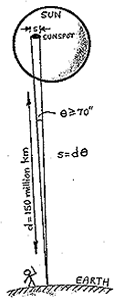Naked Eye Sunspots
It is, of course, quite dangerous to look at the Sun with the naked eye. The infrared radiation focussed by the lens of the eye can burn out the visually sensitive cells (rods and cones) in a fraction of a second. Despite this, we have historical accounts of observers seeing sunspots on the solar surface long before the telescope was invented. The Chinese, in particular, have maintained records of naked eye sunspot visibility dating back over 2000 years.
Such observations are made under unusual conditions whereby the sunlight has been significantly attenuated. This may occur in fog, with thin cloud, near sunrise or sunset, particularly when there is a high dust or other aerosol concentration in the atmosphere. Although it is not unusual to view sunspots under these conditions, the sunspot or sunspot group has to be relatively large.
We can calculate the size of a sunspot necessary for unaided visual observation. We start with the Rayleigh resolution criterion which relates the minimum observable angle to the size of the optical aperture - in this case the pupil of the eye.

The pupil diameter normally varies between 1 and 5 mm, depending on the ambient brightness. If we take 1.5 mm as the maximum dilation in relatively bright light, and the mean wavelength of visible light as 500 nanometres, we find a resolution of 3.3x10-4 radians or 70 arc seconds.
To subtend this angle at the Earth, a sunspot would have to be about 50,000 km in diameter and it would occupy an area of two billion (2000 million) square kilometres or 700 millionths of the visible solar hemisphere and extend over 4 heliographic degrees (along a solar great circle).
While this is extremely large in terrestrial terms, approximately 2 to 3% of all sunspot groups will have this area. Based on recent solar cycle (approximately 11 years in duration) data, we might expect that about 100 sunspots or compact sunspot groups will be visible to the unaided eye during a solar cycle. Most of these will occur in the 2 or 3 years around the peak of the sunspot cycle, and experience has shown that at sunspot maximum it is not unusual that up to 4 such groups may be present on the solar disc at one time.
If you feel inclined to perform your own experiments, we can only recommend in the strongest terms that you purchase an approved solar filter from a reputable astronomical supplies dealer. Such filters are available for a few tens of dollars. Even safer is to use one side of a pair of binoculars to project an image of the Sun onto a sheet of white paper (which needs to be in the shade). This will allow you to see many more sunspot groups than is possible with the appropriately filtered naked eye.

Material prepared by John Kennwell




